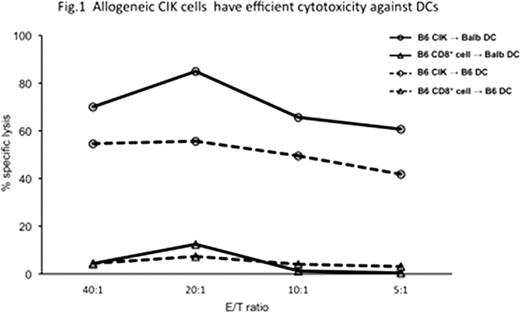Abstract
Abstract 4308
Cytokine-induced killer (CIK) cells are ex vivo–expanded T lymphocytes expressing both natural killer (NK)– and T-cell markers. We have reported that adoptive transfer of allogeneic CIK cells in a murine model caused minimal graft-versus-host disease (GVHD) with retention of antitumor activity mediated by NKG2D, which is an activating receptor expressed on NK cells. The mechanism of suppression of GVHD after allogeneic bone marrow transplantation is, in part, due to the abundant production of IFN-gamma from the CIK cells, which has protective effect against GVHD. We have also demonstrated that allogeneic CIK cells displayed a significant lower acquisition of homing molecules, required for the entry of inflamed and GVHD target organs (a4b7, CCR9, E-selectin, CXCR3, and CCR5) and a higher susceptibility to apoptosis compared to allogeneic splenocytes. There also might be some causes other than we mentioned above. Host residual dendritic cells (DCs) have a crucial role for initiating GVHD reaction, because they present recipient alloantigens to donor T cells, which finally attack on recipient tissues. Murine alloreactive NK cells, even when infused in large numbers, do not cause GVHD in the mouse by killing recipient DCs. Similarly, it remains a possibility that the reduced GVHD in CIK cells receiving mice was due to the elimination of residual host DCs by CIK cells. To test this, DCs generated from bone marrow cells with the addition of GM-CSF were used for 51Cr release cytotoxicity assays as target cells. Although autologous CIK cells (Balb/c) had relatively strong killing activity against DCs (Balb/c), allogeneic CIK cells (B6) had much more killing activity even from at a 5:1 effector-target ratio as shown below. Allogeneic CD8+ cells did not show any killing activity against DCs. In addition, killing activity against DCs did not changed with/without adding NKG2D blocking antibody, suggesting that other mechanisms to undergo cell lysis should exist in CIK cells in addition to NKG2D/NKG2D ligand system, which are mainly involved in tumor eradication. To further evaluate whether allogeneic CIK cells kill host DCs in vivo, lethally irradiated Balb/c recipients were given BM (B6) with CIK cells or splenocytes to compare the percent of residual host-typed DCs in the spleen five days after bone marrow transplantation. Percent of host-typed DCs tended to be lower in the mice receiving alllogeneic CIK cells compared with those receiving fresh splenocytes or BM alone. In conclusion, allogeneic CIK cells caused less GVHD due in part to elimination of host DCs.
No relevant conflicts of interest to declare.
Author notes
Asterisk with author names denotes non-ASH members.


This feature is available to Subscribers Only
Sign In or Create an Account Close Modal